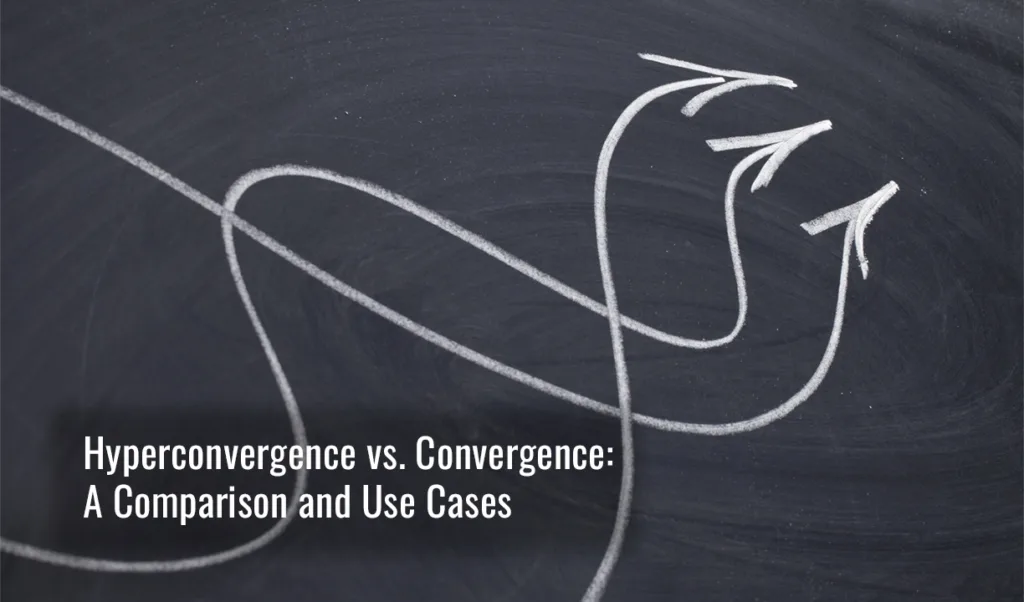
If you’ve wondered how Convergence vs Hyperconvergence (HCI) differ, you’re in good company. It’s not always clear how these two models compare, especially as the goals of both HCI and converged infrastructure are similar. Both aim to consolidate complex IT environments into more unified and easily managed solutions. In this post, we’ll explore the match-up: Hyperconvergence vs. Convergence.
Convergence vs Hyperconvergence – What’s the difference?
Converged and hyperconverged infrastructure arose from the need to simplify the increasingly complicated procurement and management tasks required by the diversity of today’s hybrid IT environments. HCI and converged aim for a more modular approach that can be scaled quickly without costly and time-consuming integration, configuration, and management work.
Fully 40% of IT staff time today is spent on the daily routine of monitoring, troubleshooting, and managing systems, according to IDC’s research director Jennifer Cooke. That’s a significant amount of time that could be better spent on strategic IT projects. Cooke noted in her recent whitepaper Rethinking BYOC (Build Your Own Cloud) that, “With business needs increasingly dependent on IT’s ability to innovate, IT leaders recognize the importance of shifting the time spent on managing equipment to time spent on high-value IT initiatives.”
But converged infrastructure and HCI differ in their basic construction. A converged infrastructure solution is based on the pre-assembly of hardware components, while HCI is rooted in software.
What is converged infrastructure or “converged” systems?
A converged infrastructure (CI) solution is a bit like a “data center in a box”, with all the networking, storage resources, and server hardware pre-selected, pre-configured, tested and unified on a single hardware appliance.
An IT department that already has some of the vendor-specified hardware can also buy just a converged reference architecture on which to base its own custom solution. This DIY approach may be attractive to IT departments that want to re-use existing hardware investments or that need a highly customized converged infrastructure solution.
What is hyperconverged infrastructure (HCI)?
HCI is infrastructure a software-defined “platform in a box” with computing, storage, and networking resources tightly integrated and installed on a commodity x86 server. This HCI equipment can then be stacked and managed as clusters.
An HCI platform includes software-defined storage, a hypervisor for virtualized computing, an operating system, and virtualized networking, all managed through a single system management console. An organization can also opt to build its own hyperconverged system by purchasing a vendor’s HCI software platform and implementing it on any of the x86 servers on the vendor’s list of approved hardware. Learn how Hyperconverged Infrastructure is changing the way we run data centers.
What are the major advantages of hyperconverged and converged infrastructures?
Both converged infrastructure and HCI solutions offer important advantages. These include:
Rapid deployment
Plug-and-play computing environments speed procurement and deployment. Much of the work of buying and configuring hardware, implementing the software platform, and connecting cables is done for you. That benefit is diminished if you go the DIY route, as you’ll have to buy and configure your hardware, cables, etc. The upside is that a converged infrastructure and HCI come with guidelines and lists of approved hardware which can save time on deployment.
Scalability and upgrades
Rapid scalability is a goal for both infrastructure models. You can scale up by simply adding storage/memory to existing nodes or to just add an additional node to the cluster. A converged infrastructure solution can be upgraded by swapping out individual hardware components and replacing them with upgraded hardware, as long as it’s from the vendor-approved list.
Depending on the vendor, the list might be quite short. Additionally, upgrading converged infrastructure requires the customer to configure and integrate components. This may sometimes require support from the vendor or a managed services provider.
Simplified management
HCI and converged infrastructure are both easier to manage than traditional IT because system management is consolidated under fewer interfaces. In traditional three-tier infrastructures, each hardware component may have its own management interface.
Converged infrastructure solutions replace the many interfaces with fewer—in some cases just a single interface. Likewise, an HCI cluster provides a unified management portal for all system management. That not only saves time but reduces the expertise required by IT staff.
Hyperconvergence vs. convergence: Use cases
HCI is great for small or new applications that are planned to scale (thanks to HCI’s flexible design). Common uses of HCI are:
- disaster recovery and backup
- remote or branch office
- point-of-sale machines
- shared storage clusters
- virtual desktop deployments
- private cloud development
- software-defined data centers
Converged infrastructure can support a greater diversity of workload requirements. You’ll find it deployed for such projects as new data center construction, private cloud development, virtual data centers or data center renovations, and resource-intensive applications.
Converged infrastructure and HCI are part of a general trend to make sophisticated IT environments more affordable and manageable for smaller IT departments. Just as Software as a Service has enabled small companies to access high-end enterprise applications, hyperconverged and converged architectures are enabling them to deploy advanced IT environments. This enables new technologies, like edge computing, private cloud, and software-defined data centers and to compete more effectively in the digital marketplace.
Hyperconvergence, Convergence, Cloud? Don’t go it alone
No matter what your path is to IT transformation, we’ll meet you along the way to achieve your goals. By using our hosted private cloud with HCI, your enterprise can achieve the scalability of a data center, without the overhead that comes with maintaining an on-premises data center. Contact us to learn more.

Learn more about the importance of hyperconverged infrastructure, download our complimentary IDC white paper: Rethinking BYOC (Build Your Own Cloud): How Partners Accelerate Digital Transformation Goals.
Originally published in January 2020, this post was updated on April 1, 2021 to further simplify and explain hyperconvergence benefits to readers.
